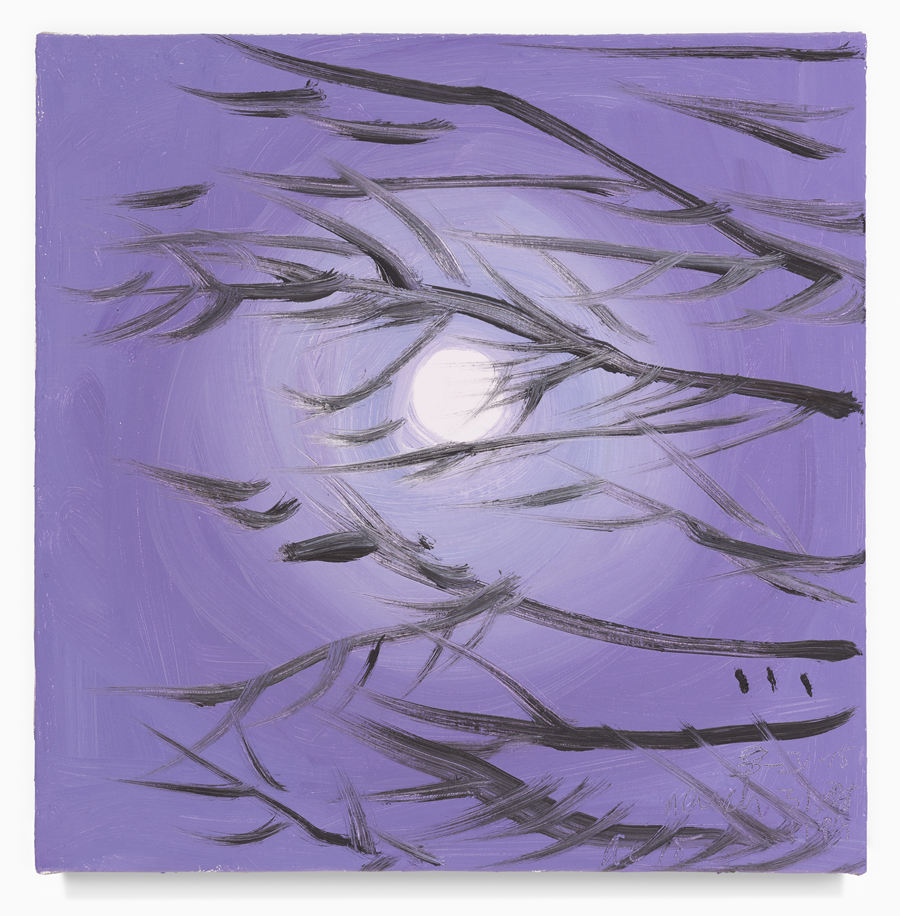Ann Craven’s Changing Scenes Of The Continuous ‘Just Past’
At Karma, New York, the artist herself becomes ‘a reproductive medium’, revisiting natural subjects and bringing realism ever closer to abstraction
At Karma, New York, the artist herself becomes ‘a reproductive medium’, revisiting natural subjects and bringing realism ever closer to abstraction

Ann Craven’s bright birds – oil painting enlargements of photographs from a single, out-of-print ornithology book – dare the viewer to accuse nature of kitsch. Craven has been painting such works annually for the better part of two decades, and in their persistent repetition, they almost read like works by Elaine Sturtevant, but with inverted aims: both artists reproduce the familiar faithfully and without irony, creating a personal style out of received images. But, rather than reflecting back contemporary art, Craven reproduces images that, in their original media, were unstylized (or unstylish).
The main room of her exhibition ‘Sunset Moon’ showcases six 2.3 x 1.8 metre oil paintings, evenly divided between the show’s two subjects (birds and moons). On one wall, two similar full moons – Lavender Moon (Bluish light), 2018 (all works 2018) and Bright Lavender Moon, 2018 – each with an aura of light bleeding into the surrounding purple sky, peer out from behind loosely brushed, foregrounded branches. The birds gripping tightly to branches on the opposite wall are much more distinct from each other. The feathers and feet of the bird in Pink Canary (Stepping Out, on Pink Sunset), 2018 share the pink and orange of their framing sunset, while to the canary’s left, the two green parrots in another work canoodle on a stick. Nearby, the first quarter moon of Sunset Moon (Guilford, Through Trees), 2018 weds the visual elements of all of the surrounding paintings, sharing the birds’ pink and orange horizon and the shades of lavender in the nocturnal works. A back room houses smaller ‘Lavender Moon’ and ‘Sunset Moon’ paintings – the latter are all dated 21 May of this year and note times between 7 and 7:45pm.

On its own, Lovebirds (Yellow Flowers on Pink Sunset), 2018 – a single painting of green parrots set off against a diagonal, orange horizon separating blue sky from pink ground – might emphasize its subjects’ feathers, or the curved line where their chests overlap. Taken within the greater context of the show, though, Craven’s avian portraits instead offer evidence of the artistic process: the shared colour palette, the orange horizon that starts anew at the edge of each canvas, the sequential dates written in corners. Repetition distances its subject, such that the works in ‘Sunset Moon’ seem to be about time as much as they are of animals or orbs waxing gibbous. This is especially true of the smaller paintings in the back gallery.
Craven describes her process as an attempt to capture ‘the continuous just past’, echoing Gertrude Stein’s essay ‘Composition as Explanation’ (1926) in its argument for a naturalist grammar. Describing her literary portraits of her contemporaries, Stein writes: ‘I naturally made a continuous present an including everything and a beginning again and again within a very small thing.’ Craven also takes a small thing and begins again, but her ‘just past’ is a very different temporality – one associated with the Polaroid or snapshot – where what is natural about time is its having lapsed.

In the show’s accompanying monograph, Whitney Museum of American Art curator Dana Miller notes that Craven’s work eschews a focus on reproductive media: ‘Unlike most artists following in Andy Warhol’s wake, Craven tackles the thorny issue of original/copy using oil and brush rather than the mechanical tools of camera, printer or Photoshop.’ But her paintings do maintain references to photography, especially in their use of perspective. In Lovebirds, for example, the brushstrokes forming the beaks’ arc suggest a camera’s sharp focus, while yellow petals and purple pistils blur together into background. The show’s poster also curiously depicts a photographed bird, rather than one of the artist’s paintings. Given Craven’s technique of repainting earlier work from memory, restaging shows and revisiting subjects, we get the sense that the artist herself is a reproductive medium. With each repetition, representation comes closer to abstraction, realism becomes automatic or unconscious production, and the widely-familiar transforms into personal iconography.
Ann Craven ‘Sunset Moon’ was on view at Karma, New York, from 21 June until 3 August 2018.
Main image: Ann Craven, Pink Canary (Stepping Out, on Pink Sunset), 2018 (detail), 2018, oil on canvas, 2.3 × 1.8 m. Courtesy: the artist and Karma, New York
























